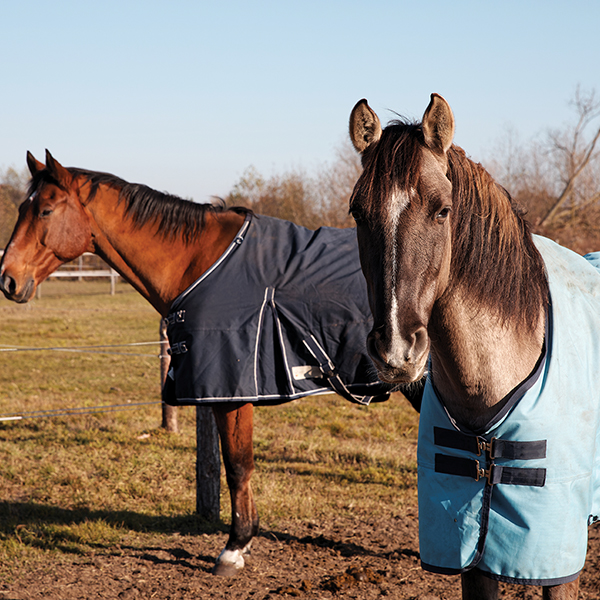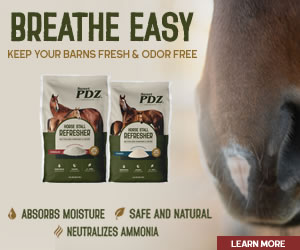Fall is an excellent time of year to prepare and brace your horses and barn for the approaching winter. The cold season brings distinct challenges for horse owners, especially regarding how to ensure their equine companions remain warm and comfortable. Whether you love them or not, blankets can be essential for helping horse owners and their horses endure the harsh conditions of winter.
Blankets are a fantastic investment for horse owners’ and can last years if managed and cared for appropriately. Not every owner chooses to blanket his or her horse. Not every horse needs to be blanketed. However, there are some things to consider while deciding if blanketing is right for you and your horse.
To Blanket or Not to Blanket
Just as humans can wear different coats based on the weather, horses require various types of blankets to suit their needs. The type of blanket your horse requires depends on several factors:
Is your horse clipped? Horses with clipped coats lack natural insulation. Horses with naturally thick coats have better thermo regulation. When a horse is clipped their natural difference against cold weather is gone, which means your horse will require a blanket during winter.
Does your horse have access to a shelter? Horses with limited access to shelter may require more robust protection like a blanket. Shelters should be three-sided structures and be large enough to fit every horse in the herd.
Age and Body Condition: Senior horses generally have a hard time maintaining their body temperature in extreme cold. Senior horses can also have lower body fat. If your horse is leaner (a 4 or a low 5 on a scale of 1-9) a blanket will be beneficial since they do not have as much fat insulation.
What are the Weather Conditions? Wet and cold weather can impede a horse’s ability to thermo regulate, even with a thick natural coat. When hair is wet, it CANNOT stand up on end to circulate warm air around the horse’s body. Rain, sleet, and snow can disrupt thermo regulation, making it essential to provide a blanket for your horse or herd when they remain outside during such winter weather events.
Blanket Types and Their Uses
Just like types of winter coats, horse turnout blankets have different levels of “fillings” or insulation to keep horses dry and warm. Here is a breakdown of all types of blankets and sheets available and their level of insulation.
Turnout Sheets: Comparable to a raincoat, these provide protection from rain in mild temperatures (above 50°F) but lack insulation. Ideal for warmer fall or spring days.
Light Turnout Blankets: Offer minimal insulation for horses with thick natural coats, suitable for layering. Turnout sheets and light turnout blankets have 0-100 grams of fill
Medium Turnout Blankets: Provide moderate insulation, commonly used for unclipped horses. Medium blankets have 150-250 grams of fill.
Heavy Turnout Blankets: Offer maximum insulation, perfect for clipped horses or extremely cold conditions. Heavy Blankets have 300+ grams of fill.
Getting the Right Fit
The fit of your horse’s blanket is crucial, as a blanket or straps that are too tight or too loose can pose safety risks. When selecting a blanket, it’s essential to know the following measurements:
Length: The blanket should fall just in front of the withers and extend to the tail, ensuring that the seam between the blanket and tail flap aligns with the base of the tail. If the hindquarters are visible from the side, the blanket is too short.
Height: The hemline should ideally fall above the horse’s knees and hocks, ensuring that the belly remains covered from the sides. If the hemline reaches or goes below the knees and hocks, it indicates that it is too large.
Chest and Shoulders: The fabric should overlap when the buckles are secured near the center of the chest. If the fabric does not overlap, it indicates that the blanket is too small.
Neck and shoulders: The neck opening of the blanket should fit snugly around the neck while allowing enough flexibility to slide your hand down the neck. It should not appear tightly stretched across the shoulders; if the shoulders are exposed or protruding near the neck opening, the fit is incorrect. The design should permit free movement without being so loose that it lets rain or snow seep in.
Belly and Leg Straps: Allow a hand’s width between the straps and the horse’s body to prevent rubbing and ensure freedom of movement.
Leg straps: There should be a space equal to one hand’s width between each strap and the leg it encircles. This ensures both comfort and freedom of movement while preventing any rubbing.
For detailed measuring instructions, visit Dover Saddlery’s guide at: https://www.doversaddlery.com/how-to-measure-your-horse-for-a-blanket/a/431/
Blanketing Management Tips
Investing in blankets for your horse is essential, especially since most horses require multiple options. Here are some quick tips to help you extend the lifespan of your horse’s blankets.
Damage Control: We all know that horses have a knack for tearing up their blankets. Whenever your horse is wearing one, be sure to check for any tears or rips and repair them promptly. Additionally, inspect the stitching, lining, buckles, and straps for any wear and tear. Many tack shops offer blanket repair services, which can be very helpful. It’s always wise to have a backup blanket on hand while your horse’s primary blanket is being mended.
Washing: The simplest way to clean blankets is to take them to a professional washing and repair service. The metal clips and buckles can potentially damage your home washer and dryer, and at-home appliances may not effectively clean a blanket. If you prefer to wash it yourself, start by brushing off any dirt, mud, or hair with a stiff brush. Then, rinse the blanket with a gentle stream from a garden hose and use a detergent specifically formulated for blankets. After washing, hang the blanket to dry—do not tumble dry it.
Storage: Once repairs are complete and the blanket is clean and dry, it’s important to store it in a cool, dry place. Excessive heat, moisture, and UV exposure can harm the fabric. Using a breathable storage bag is the ideal choice. Avoid simply cramming the blanket into the bag; instead, fold it neatly to minimize space.
Take Aways
Blanketing your horse during winter is an essential part of equine care, ensuring they remain warm, dry, and comfortable throughout the season. By selecting the right blanket type, ensuring proper fit, and maintaining blankets with care, you can protect your horse from the elements and enhance their well-being.
Staying proactive with blanket management can reduce stress and prevent mishaps, making winter a more enjoyable time for both you and your horse. If you have any questions about horse blanketing management, feel free to contact your local extension office.
Remember, a well-blanketed horse is a happy horse, and your efforts to ensure their comfort will pay dividends in their health and happiness.
Kyla Szemplinski, MS, is an Extension Agent I and 4-H Agricenter Youth Development for UT TSU Shelby County Extension. She serves Shelby County, Tennessee equine community, and can be contacted at the Shelby County office at 901-752-1207 during normal business hours Monday-Friday 8am-4:30pm CST.









